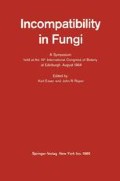Abstract
Heterothallism in the Euascomycetes has been of interest to mycologists ever since its discovery by Dodge (1920) in Ascobolus magnificus. In this classic paper, he showed that heterothallism in this species is a genetically determined condition in which the two mating groups (A, a) are determined by the two alleles (A, a) at a single locus. About a decade later, Gwynne-Vaughan and Williamson (1932) proved that the two mating groups are not the opposite sexes; that is, all strains are hermaphroditic.

Access this chapter
Tax calculation will be finalised at checkout
Purchases are for personal use only
Preview
Unable to display preview. Download preview PDF.
References
Bistis, G.N.: Studies on the genetics of Ascobolus stercorarius. (Bull.) Schrot. Bull. Torrey Botan. Club 83, 35–61 (1956a).
Bistis,G.N.: Sexuality in Ascobolus stercorarius I. Morphology of the ascogonium; plasmogamy; evidence for a sexual hormonal mechanism. Am. J. Botany 43, 389–394 (1956b).
Bistis,G.N.: Sexuality in Ascobolus stercorarius II. Preliminary experiments on various aspects of the sexual process. Am. J. Botany 44, 436–443 (1957).
Bistis, G.N., and J. R. Raper: Heterothallism and sexuality in Ascobolus stercorarius. Am. J. Botany 50, 880–891 (1963).
Catcheside, D.G.: The Genetics of Micro-organisms. New York: Pitman 1957.
Dodge,B.O.: The life history of Ascobolus magnificus. Mycologia 12, 115–134 (1920).
Dowding, E. S.: The sexuality of Ascobolus stercorarius and the transportation of the oidia by mites and flies. Ann. Botany 45, 621–638 (1931).
Esser,K.: Die Incompatabilitätsbeziehungen zwischen geographischen Rassen von Podospora anserina. II. Die Wirkungsweise der Semi-Incompatibilitäts-Gene. Z. Vererb.-L. 90, 29–52 (1959).
Gwynne-Vaughan, H.C.I., and H.S. Williamson: The cytology and development of Ascobolus magnifions. Ann. Botany 46, 653–670 (1932).
Janczewski, E.G.: Morphologische Untersuchungen über Ascobolus furfuraceus. Z. Botan. 29, 256–262 (1871).
Raper, J. R.: Life cycles, sexuality, and sexual mechanisms in fungi. Sex in Microorganisms: 42–81. Am. Assoc. Advance. Sci., New York, New York 1954.
Raper, J. R.: The control of sex in fungi. Am. J. Botany 47, 794–808 (1960).
Seaver,F. J.: The North American cup-fungi (Operculates). New York 1942.
Zickler, H.: Zur Entwicklungsgeschichte des Askomyzeten Bombardia lunata. Arch. Protistenk. 98, 1–70 (1952).
Editor information
Editors and Affiliations
Rights and permissions
Copyright information
© 1965 Springer-Verlag Berlin · Heidelberg
About this chapter
Cite this chapter
Bistis, G.N. (1965). The function of the mating-type locus in filamentous Ascomycetes. In: Esser, K., Raper, J.R. (eds) Incompatibility in Fungi. Springer, Berlin, Heidelberg. https://doi.org/10.1007/978-3-642-87052-1_4
Download citation
DOI: https://doi.org/10.1007/978-3-642-87052-1_4
Publisher Name: Springer, Berlin, Heidelberg
Print ISBN: 978-3-540-03334-9
Online ISBN: 978-3-642-87052-1
eBook Packages: Springer Book Archive

